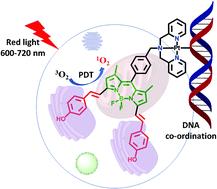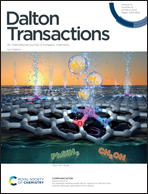BODIPY–dipicolylamine complexes of platinum(ii): X-ray structure, cellular imaging and organelle-specific near-IR light type-II PDT†
Abstract
Dipicolylamine (dpa) based platinum(II) complexes [Pt(L1–3)Cl]Cl (1–3), where L2 and L3 are green and red light BODIPY-tagged dpa ligands and L1 is a benzyl derivative of dpa, were synthesized and characterized and their in vitro cytotoxicity was studied. The perchlorate salt of complex 2 was structurally characterized. It showed a PtN3Cl core with a deformed square-planar geometry. At pH 7.2, complexes 2 and 3 showed strong absorption bands at 500 nm (ε ∼6.8 × 104 dm3 mol−1 cm−1) and 653 nm (ε ∼1.0 × 105 dm3 mol−1 cm−1) in a 1 : 1 (v/v) mixture of dimethyl sulfoxide and Dulbecco's phosphate-buffered saline (DMSO/DPBS), respectively. They displayed respective emission bands at 515 and 677 nm having fluorescence quantum yield values of 0.36 and 0.25. Complex 3 generated singlet oxygen, as evidenced from the 1,3-diphenylisobenzofuran titration experiments and mechanistic DNA photocleavage study. It showed high photocytotoxicity in red light (600–720 nm) with half-maximal inhibitory concentration (IC50) values of 1.73 and 2.67 μM in HeLa and A549 cells. The complexes showed significantly reduced chemo-PDT activity in a non-cancerous HPL1D cell line and in the dark. The 2′,7′-dichlorofluorescein diacetate assay revealed reactive oxygen species-mediated type-II photodynamic therapy (PDT) activity. Cellular imaging of A549 cancer cells using complexes 2 and 3 revealed their preferential localization in mitochondria and endoplasmic reticulum. The annexin V-FITC/PI assay confirmed apoptotic cell damage. Cell cycle analysis indicated arrest in the G1 phase upon red light irradiation. Pt–DNA adduct formation was proposed from a DNA binding experiment with green light active complex 2 and 9-ethylguanine as a nucleobase from the mass spectral study.



 Please wait while we load your content...
Please wait while we load your content...